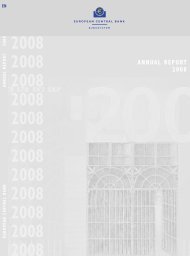Explaining Currency: New Zealand's bank notes and coins
Explaining Currency: New Zealand's bank notes and coins
Explaining Currency: New Zealand's bank notes and coins
You also want an ePaper? Increase the reach of your titles
YUMPU automatically turns print PDFs into web optimized ePapers that Google loves.
‘imperial’ system of currency was complicated <strong>and</strong> difficultto master. Under the imperial system, pounds were dividedinto twenty shillings, <strong>and</strong> subdivided further into 240 pence(making twelve pence per shilling). In 1933, decimal currencywas rejected because it would have been too expensive toput in place at that time, especially as <strong>New</strong> Zeal<strong>and</strong> was inthe midst of the Great Depression.In 1957, a special committee was set up by the Governmentto take another look at the pros <strong>and</strong> cons of decimal currency.This committee supported the introduction of the decimalsystem <strong>and</strong> paved the way for <strong>New</strong> Zeal<strong>and</strong>’s move to decimalcurrency. In August 1963, the Government announced that10 July 1967 would be ‘DC Day’, <strong>and</strong> a massive publicitycampaign was organised to smooth the shift from the imperialto decimal system.Public discussions were held as to what the new decimal unitmight be called, <strong>and</strong> suggestions such as the “kiwi” <strong>and</strong> the“zeal” were debated before the “dollar” was finally settledupon. Many <strong>New</strong> Zeal<strong>and</strong>ers remember “Mr Dollar”, acartoon character that symbolised the changeover. On DCDay, dollars <strong>and</strong> cents replaced pounds, shillings <strong>and</strong> penceas <strong>New</strong> Zeal<strong>and</strong>’s units of currency.In 1990, the Reserve Bank decided to completely revamp theappearance <strong>and</strong> features of <strong>New</strong> Zeal<strong>and</strong>’s <strong>bank</strong> <strong>notes</strong> - thefirst overhaul since the introduction of decimal currency in1967. The result, after the Reserve Bank had consulted widelywith the <strong>New</strong> Zeal<strong>and</strong> public, was an all-new series of <strong>notes</strong>with a distinctive <strong>New</strong> Zeal<strong>and</strong> look. The designs of the <strong>notes</strong>were changed slightly in 1999 when the Reserve Bankintroduced polymer <strong>bank</strong> <strong>notes</strong>. These designs are detailedon pages 8-12.Defacing <strong>bank</strong> <strong>notes</strong>The Reserve Bank Act 1989 says that “No person shall,without the prior consent of the Bank, wilfully deface,disfigure, or mutilate any <strong>bank</strong> note.” A person can be finedup to $1,000 if caught defacing a <strong>bank</strong> note.Are damaged <strong>notes</strong> worthanything?If you come across a badly damaged <strong>bank</strong> note, don’t throwit away, as it will normally have some value. The ReserveBank is liable to pay on currency it issues, provided that thenote is not so badly damaged that it is unrecognisable. Inextreme cases, individual assessments of <strong>notes</strong> may need tobe made. As a rule of thumb, if you have half a note, theReserve Bank will pay half its value. To receive payment on adamaged note, you need to present it to a <strong>bank</strong> or to theReserve Bank in Wellington.Real <strong>notes</strong> fluoresce under ultraviolet light. An operatorin the Reserve Bank checks a note for validity.Reproducing or imitatingcurrencyIt is an offence to reproduce or imitate currency without theprior consent of the Reserve Bank. The Reserve Bank Actsays that you cannot “make, design, engrave, print, orreproduce; or use, issue, or publish any article or thingresembling a <strong>bank</strong> note or coin or so nearly resembling orhaving such a likeness to a <strong>bank</strong> note or coin as to be likelyto be confused with or mistaken for it”.<strong>Explaining</strong> <strong>Currency</strong>: <strong>New</strong> Zeal<strong>and</strong>’s <strong>bank</strong> <strong>notes</strong> <strong>and</strong> <strong>coins</strong> 19





![KNOW YOUR NEW GIBRALTAR BANKNOTES - [Home] bThe/b](https://img.yumpu.com/50890985/1/184x260/know-your-new-gibraltar-banknotes-home-bthe-b.jpg?quality=85)
![PAPUA NEW GUINEA - [Home] - Polymer Bank Notes of the World](https://img.yumpu.com/49758743/1/190x143/papua-new-guinea-home-polymer-bank-notes-of-the-world.jpg?quality=85)









